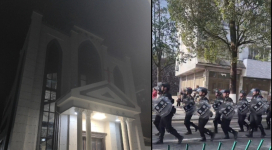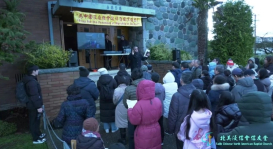ALPHARETTA, Ga. -- Good presentations of the Gospel on video and film are not hard to find, but the North American Mission Board last year was looking for something more. They wanted the rest of the story, told in a way that would appeal to postmodern culture.
Then they discovered "The Hope," an independently produced video project that is now destined to become a flagship tool for Southern Baptist evangelism and church-planting efforts -- just as the "Jesus" film of a previous generation introduced the Gospel to millions.
Using footage from some of Hollywood's finest biblical epics and other sources as a visual backdrop, three contemporary on-screen narrators, or "storytellers," guide viewers through the "scarlet thread" of Christian truth throughout Scripture.
Under terms of a partnership with the nonprofit Mars Hill Productions, NAMB is distributing The Hope for North American audiences and helping develop future versions for languages other than English and varied cultural groups.
John Yarbrough, NAMB's vice president for evangelism, said NAMB had been considering producing its own evangelistic video project last year. Then he saw The Hope.
"I watched it from beginning to end, and just basically wept as I realized this was exactly what we were looking for," he said.
While praising the Jesus film for its effectiveness around the world since it was produced more than 20 years ago, Yarbrough said a postmodern culture often needs more background in considering whether to believe.
"It begins with Jesus and sin," he said of the Jesus film. "In the culture that we're living in, that's not always going to work. People are asking questions that go beyond that, like 'Why am I here? Is there any meaning to life? What is its purpose? Is there anything beyond us? And if there is, how can I know that He has a meaning and plan for my life?'"
Mars Hill Productions, based in Missouri City, Texas, began in 1977 as a video division of Youth for Christ in Houston. It became an independent ministry in 1988.
Fred Carpenter, president of Mars Hill, said his initial goal for the The Hope was to develop an evangelistic tool that could be used globally, "something that could be adapted for every tongue, tribe or nation." His first script was "sort of a Four-Spiritual-Laws, Roman-Road basic American approach to sharing the Gospel," he said. But when he submitted the script to leaders around the world, several said it wasn't likely to work in their contexts.
"The cultures they are dealing with lack the underpinnings of Judeo-Christian culture," Carpenter said. "They have no background to understand the concepts of a holy creator God, or sin, or judgment. Why do I need a Savior if I don't understand there is anything such as sin?"
Mars Hill subsequently rewrote the entire project, Carpenter said, to include a full explanation of the Gospel "from Creation to Christ."
The production begins by posing some of the hard questions that every human being must face.
"Throughout time people have considered the world in which we live, the complexity and beauty of nature, the mystery of life and death, the depth of human joy and pain," the narrator says. "And they have wondered, how did it all come to be?"
The Hope then explains how the Bible answers those questions. It provides a solid foundation in Genesis, with three of the 12 chapters on the creation through man's fall in the Garden of Eden. Another four chapters cover Noah's flood, Abraham and his descendents, the Exodus from Egypt, the giving of the law, and the promised Messiah. It then skips forward to the fulfillment of that promise in Christ, His death and resurrection, and the rise of the early church and Christianity through history.
The production concludes with an invitation to respond to the Gospel. NAMB's version also refers viewers to the Evangelism Response Center, a network of volunteer telephone encouragers who can guide individuals in prayer for salvation and arrange for follow-up by a local Southern Baptist church.
The prominent use of "storytellers" prominently in the foreground further provides the project one of it's most exciting possibilities, Yarbrough said. In future versions to be developed by Mars Hill and NAMB, alternate "storytellers" of varied cultures can be filmed and layered over the base video. The Spanish-language version, for instance, could feature Hispanic storytellers on the screen, rather than simply overdubbing with audio. Other versions could even be made for other English-speaking subcultures.
"You could use bikers narrating the video to communicate with a bikers group," Yarbrough suggested.
The Hope is available in both single and multi-copy packages for individuals who wish to share them with friends and family members. NAMB also will be making the production available in bulk at substantially reduced costs to state conventions and other partners, Yarbrough said.
He suggested a variety of possible applications:
-- Churches could provide the video to members as a personal evangelistic tool, creating opportunities for ongoing personal discussions.
-- A viewer's guide is being developed to help facilitate discussion in small groups and neighborhood Bible studies.
-- NorthStar Church in Kennesaw, Ga., already is planning to use the video as the core of a new membership class, Yarbrough said -- based on its thorough treatment of basic Christian theology.
-- New church starts may use the video as a free mail-out, along with an announcement about a 12-part series of sermons examining each of the chapters. Existing churches could sponsor similar efforts, saying the video would be the topic of small-group meetings or weekly sermons.
An informational website for The Hope, which will include two video clips, will be active June 16 at www.namb.net/thehope.
By Albert H. Lee
chtoday_editor@chtoday.com







